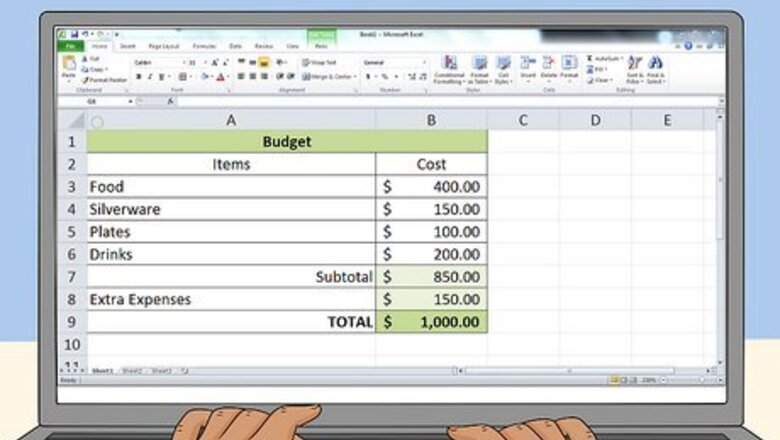
views
Preparing the Space
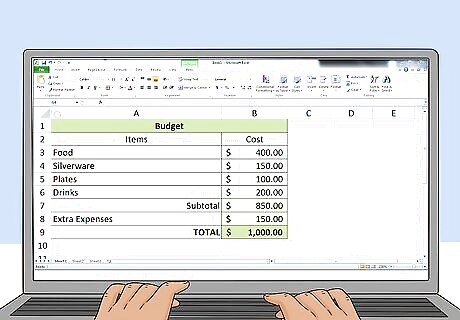
Consider your budget. Decide how much you want to spend altogether, including food, silverware, plates, and drinks. Next, reduce the amount you want to spend by 15%. The remaining 85% is what you will have to actually spend. The extra 15% allows you some extra money for unexpected costs and things like taxes, tips, and potential emergencies. Keep track of what you’re spending by keeping all of the receipts spent on the buffet together. Create a budget chart, either on a sheet of paper or in a computer program, such as Excel or Microsoft Word.
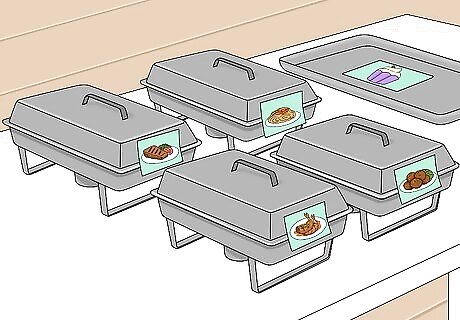
Begin planning your buffet table in advance. Gather all of your serving dishes together the night before the event and place them on the table. Attach sticky notes to remind you which food goes in which dish. Arranging your table in advance will ensure that you are not making last-minute decisions and preparations. If you have more time, consider drawing the set-up on a sheet of paper. Choose the one that you like the best, then recreate it using your table and dishes.
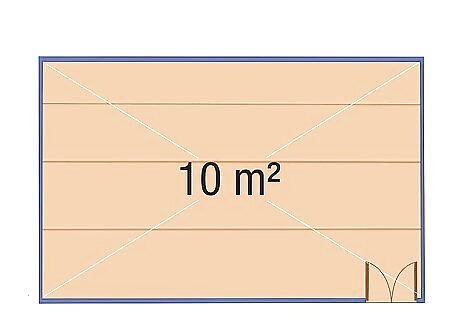
Choose a room with a lot of potential open space. Ten square meters is an ideal amount of room to fit all guests comfortably with room for getting food and mingling. Eight square meters allows for some seating, seven and a half square meters can be comfortable for smaller crowds, and six square meters should be the minimum amount of room that you designate for the buffet. If your location has multiple rooms, consider serving the food and drinks in one room, then having the seating in another room.
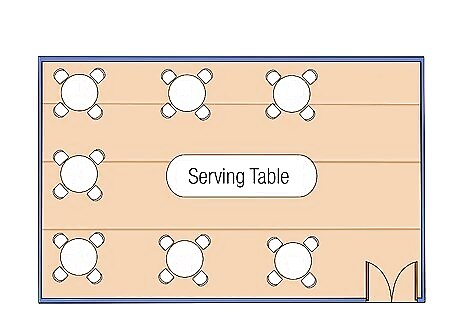
Place the table in the center of the room for the best flow. Clear the room you plan to use for your event, including all clutter, furniture, and decorations. Place the serving table in the middle of the room, then place additional tables to either side for things like plates, silverware, and cups. This will allow the guests to access to the food from both sides of the buffet table and will keep the line moving quickly. An eight-foot table will hold enough food for twenty to thirty people. You will need to put multiple tables together if you are having more people than that over. Make sure that you have a set of serving spoons and tongs for each dish--one for each side of the table.
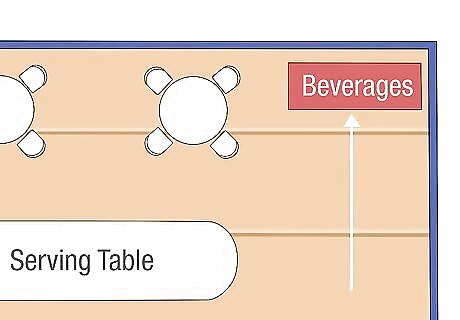
Plan a separate table for beverages. By situating the beverage table away from the food table, you give your guests a chance to choose their food and put the plates down before pouring a drink. This minimizes the potential for spills. This is another way to ensure that your guests can maneuver the lines with ease. Consider having separate tables for alcoholic and non-alcoholic beverages. Water should be served at its own table. Depending on how many guests you have, you may want to have multiple pitches. This way, your guests aren't waiting in line.
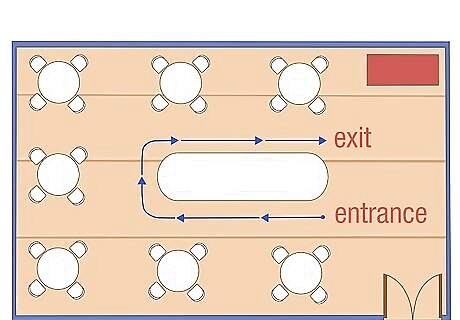
Plan traffic flow. Designate an entrance and exit to the buffet. You can do this by simply letting people know as they walk up to the table, or by making a sign for each end of the table. Leave plenty of space in front of and on the sides of the table, just in case people decide to pause for a moment. This reduces the chance of crowding. Keep the types of food as separated as possible. For example, keep dessert far from the first course of the meal. If you will have vegetarian and/or vegan options, it might be a good idea to keep those separate from the non-vegetarian and non-vegan tables. Consider having a smaller table set aside for appetizers. You can place this closer to the wine or champagne table, even.
Setting up the Table
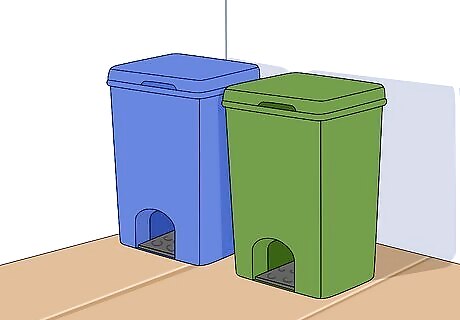
Recall any difficulties you’ve experienced with past buffets. Consider what was annoying or difficult the last time you went to a buffet. Think about what you would have liked during a buffet and plan your table around that idea. For example: If you wished you had room to set a plate down momentarily, leave enough extra space on the buffet table for people to do so. If you wished you had the option of tasting the food first, leave toothpicks or little spoons next to the dishes for your guests so that they can try the food. If you ran into issues with trash, consider setting up more trash bins and making them more noticeable so that guests can easily spot them.
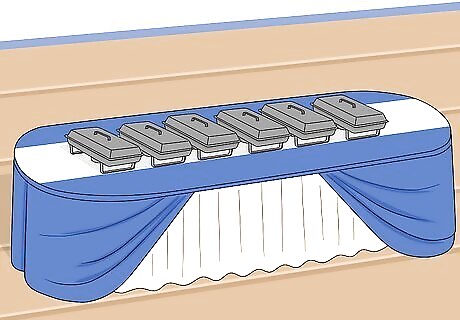
Have a nice presentation. Think about what type of plates, cups, utensils, containers, and tablecloth you would like to use for your table. You don’t have to use your fine china, but a table is more appetizing if the set up looks nice. It’s okay to use plastic silverware, plates, and cups, as long as it is all new and clean. Don’t put your food out in greasy, cardboard boxes. Instead, use plastic or metal containers. You will also need a tablecloth. An expensive tablecloth will potentially get ruined by the mess, but look for one that adds cheer to the table. Decide on a color or a theme when putting out everything on the table. This will bring the look of the table together and make the meal look more appealing. Sometimes, less is more when it comes to decorations. Rather than choosing lots of colors and patterns, stick with just one or two solid colors instead. Many catering places will offer things like plates, cups, and silverware. Rental places for tables and chairs will sometimes have tablecloths that you can borrow as well.
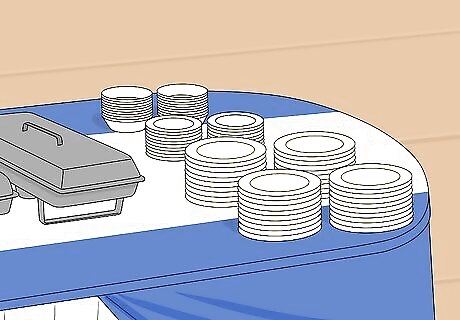
Place the plates at the start of the line. Your guests can’t access the food well without first having plates available. If you are planning an event with a lot of people, it is a good idea to set up a buffet with two or three stacks of plates of about ten plates each. You don't, however, want to pile the plates too high, or they will be in danger of tipping over. Be sure to put condiments near the type of food they belong with. If you have separate tables for things like appetizers and desserts, you will need to add tables for plates near them as well.
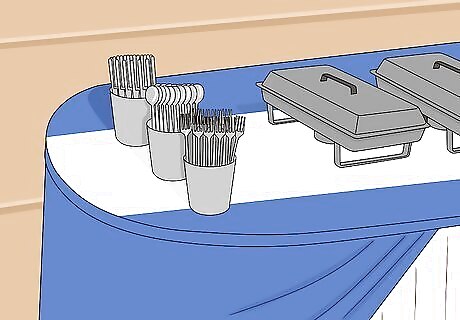
Put silverware at the end of the table. Finish the table with the utensils and napkins. A common mistake made by many hosts when planning an event is to place utensils and napkins at the front of the table. It can be cumbersome to try to hold on to knives, forks, spoons, and linens along with a plate while your guests are trying to serve themselves. Make sure you put out all types of silverware that will be needed. For example, don’t forget spoons if there will be soup.
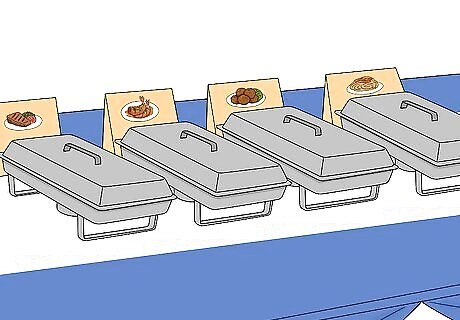
Make labels. Prepare labels for each dish ahead of time. This can be on small pieces of paper, sticky notes, or cardboard. Put the labels next to each dish once all of the food is out on the table. This will allow guests to know what the dish is before they put it on their plate, which helps eliminate a lot of uneaten and thrown away food. Make sure the labels are written in bold, large, and clear writing that all guests will be able to read with ease. Typed labels will be more legible than handwritten labels. If a food contains a common allergen, such as peanuts, it would be a good idea to add a warning label as well, such as: Contains Peanuts. If you know that some of your guests are vegetarian or vegan, it would be nice to mention which dishes contain meat or dairy.
Putting Out Food
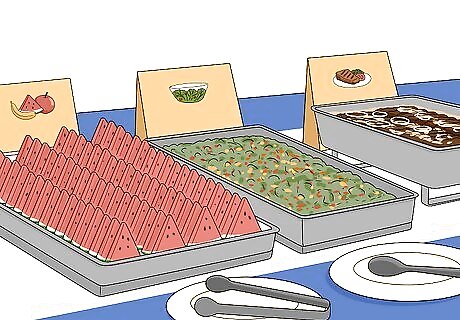
Provide a balanced meal. Plan a meal with a salad, protein, vegetable, starch, carbohydrate, and dessert, unless you are throwing a cocktail party. Buffet meals can feel scattered and uneven. Sometimes there are too many appetizers, side dishes, or main plates. Planning a balanced meal will help you avoid this problem. If you are having a cocktail party, it is okay to only serve a variety of appetizers and desserts. You can rarely go wrong by including a vegetable and fruit tray. Make sure to put out a vegetarian or vegan option.

Plan the food according to the season. The type of food we eat for meals often changes with the seasons. During summer, it feels tiring to eat a heavy meal filled with potatoes and meats. While during the winter, a light salad and lean fish may feel too light. Fruits that contain a lot of water are great for summer buffets, like watermelon. Rich foods, like cheesy mash potatoes, are good for winter meals.
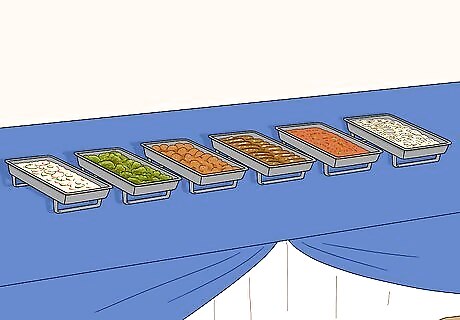
Choose six to eight items. You don’t want to have too few or too many items to choose from. Too few items can leave some guests without food or choice if they don’t like everything you’ve served. Too many choices may cause a more convoluted line with too much leftover food. Six to eight items is a good amount to give everyone enough choices. The serving size depends on the number of people you are expecting. You can send out a list of ideas for dishes and ask for feedback a week or two before the buffet. Be sure to have a variety of food. Don't have six or eight all-meat items. Include dishes with vegetables and grains in them as well. If you'll be serving meat, try to have two different choices, such as chicken and fish, rather than two chicken dishes.
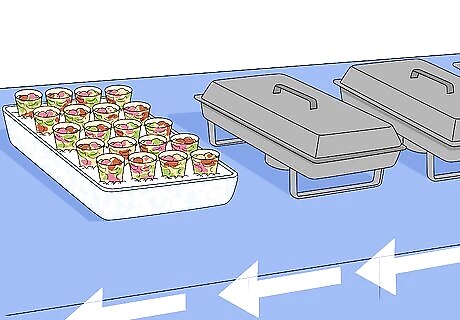
Line up the food according to temperature. The first stop on the food line should be the hot foods. You want the guests to get to these first before they cool down too much. This way, your guests won't be dining on cold main courses when they find their seats. The cold foods should be at the end of the table. If possible, it is best to choose room temperature. Put out chafing dishes to keep foods hot, and ice platters to keep food cold.
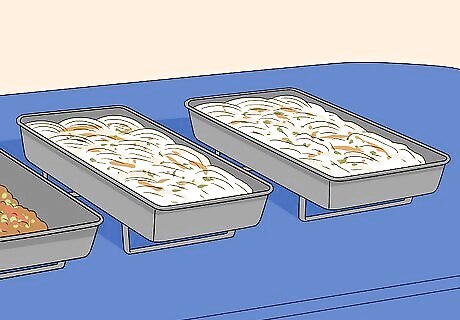
Arrange the food strategically. Put the cheapest and the food you have the most of at the beginning of the table. Put the most expensive and scarce food at the end of the table. It is a good idea to set it up this way because the food at the beginning of the table typically goes the fastest. Consider switching foods during the course of the buffet. If the carrots aren’t being eaten enough, switch them out with a food that is going fast. Some foods become unappetizing the longer they sit. For example, if the salad is starting to look slimy or the casserole is congealing, switch it out! Try to add in a little variety if you're serving across multiple buffet tables.
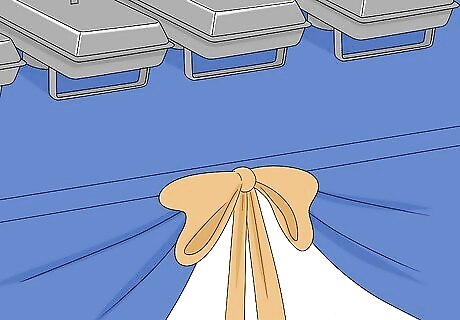
Add decorations. Once the table is set up, add decorations to amp up the appeal of the table. Don’t choose anything that will get in the way or block people. Large candles on candlesticks may not be a good idea, but placing small ribbons or bows around the table won’t get in the way of anyone reaching for food. If you’re having a buffet for a holiday, choose decorations that correspond with that holiday. Saint Patrick’s Day decorations could be green, white, and gold. A Fourth of July buffet can be decked out in red, white, and blue. If you really want candles, consider LED or battery-operated candles instead. They last longer and you don't have to worry about fire hazards. Don't get too carried away with the decorations. A scatter of confetti is better than large ornaments and figures that take up too much space. If you want to have a statement decoration, consider putting it on a table that won't be frequented, such as the cake table or drinks table.




















Comments
0 comment